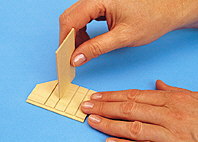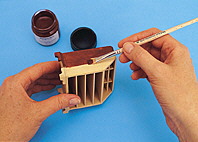We use cookies to make your experience better. To comply with the new e-Privacy directive, we need to ask for your consent to set the cookies. Learn more.
Mini Mundus Kits
|
ASSEMBLY AND FINISHING INSTRUCTION
BEFORE STARTING
Identify and account for each part by placing it on the LAYOUT SHEET. Before starting to assemble your kit, study all illustrations and instructions carefully. Be certain you understand each step before proceeding to the next one.
SANDING
Before assembly, sand all the outer surfaces of individual parts with 240 grit sandpaper or finer. Finish sanding with 320 grit sandpaper or finer. One sanding method that has proved successful is the use of a sanding platform. Tape a sheet of sandpaper of the proper grit to a hard flat surface such as a table top. Press down lightly and move the piece to be sanded in the same direction as the wood grain until the surface is smooth. Take care not to round any edges or corners of the pieces.
PRE-ASSEMBLY
After sanding, check the proper location and fit of each part, assembling parts loosely, without glueing. Use the DETAIL VEIWS as a guide. All MINI MUNDUS kits are made on precision milling machines. When minor adjustments are required, sand to fit.
TOOLS AND MATERIALS
The following working materials are required:
1 Sandpaper grain 320/400 and grain 600 (Cat No. 43020).
2 Mini Mundus wood glue (tinted).
3 Mini Mundus varnish or
Mini Mundus liquid wax and Mini Mundus clear sealer.
4 Soft brush (Cat No. 43025).
The following tools are recommended:
1 Sand block.
2 Small and large plastic clamps (Cat No. 44300, 44310).
3 Precision knife (Cat No. 44120).
GLUEING
The MINI MUNDUS Tinted Glue is matched to the finish used in the Finishing Kit. This will produce the authentic finish of the period in which the original furniture was produced. Glue should be applied in small amounts to surface being joined. When glueing groove joints apply glue to groove only. On end cuts it may be necessary to apply a second coat of glue before joining the parts. To ensure a tight fit, squeeze excess glue out of the joints. Hold glued parts together with clamps, rubber bands or weights on the parts. Wipe off excess glue promptly. Be sure a glued assembly has dried thoroughly before adding parts.
FINAL SANDING
Thoroughly wipe the entire piece with a wet cloth. After the surfaces has dried, lightly sand with 400 grit sandpaper or finer (600 grit), sanding with the grain. Your surface should, when finished, be very smooth. Remember, your final finish will only be as smooth as the surface under it. Seal end and edge grains. Using clear varnish or clear liquid wax as a sealer, apply a thin coat to all end grains with small brush. Do not allow sealer to touch other surfaces. Do not overload brush with sealer.
FINAL FINISHING WHITH MAHOGANY, OAK OR CHERRYTREE VARNISH
The MINI MUNDUS varnish enables you to finish your furniture piece perfectly. Apply a very thin coat of varnish over the entire wood surface using a small brush. Be sure there are no drop marks. This should merely be a very thin coat. Allow drying time of 8 hours or more. Repeat this procedure until you have achieved the tone you have selected.
For the Biedermeier furniture we are recommending the Cherrytree Varnish, but it is the choice of your personal taste what colour of finish you prefer.
FINAL FINISHING WITH TINTED LIQUID WAX
The Mini Mundus Liquid Wax is solventless, because it consists of natural products such as linseed oil, beeswax, carnauba wax and colour pigments.
The colour pigments of the liquid wax are sinking down (sediment) to the bottom of the can very quickly. Because of this, small mixing balls have been added to the liquid. Before opening the can for the first time, or if the wax has not been used for a longer period, shake the can strongly (in all directions), so that the mixing balls will mix up well the colour pigments and the liquid wax. It is only necessary to stir the liquid, if the mixing balls make no noise under shaking the can.
The colour pigments are very intensive, and they are staining the wood strongly. To get to know the characteristic and the intensity of the colour, it is recommended to try first on a small piece of wood or the back or bottom of the furniture.
If the liquid wax has been thickened or even showing gelatinous particles, it can be thinned out by a small amount of lighter fluid (benzine), up to a maximum of 10%.
Step 1: Application of Tinted Liquid Wax
Apply a coat of wax over the entire wood surface using a small brush (e.g. MM – Special Brush, Cat. No. 43025). The wax should not be applied too thin. It is well portioned, if the wooden surface is no longer visible. After coating the whole furniture piece, allow a drying time of 1-2 minutes. (If you should need more than 2-3 minutes for the complete coating, directly go on!). Wipe off excess wax from the surface of the furniture using a soft cotton cloth or cotton swab. Press it on strongly enough so that the wax coating is not getting too dark. Also wipe off the colour from the corners, e.g. using a toothpick covered by cotton wool.
Avoid fingerprints on fresh wax-coating! It causes light spots.
To colour the surface less intensively, it is recommended to apply a coat of clear wax (Cat. No. 43010) to the wooden surface before applying the Mahogany wax. Now you have more time to apply the tinted wax because it is now less penetrating the wood, and you can wipe off excess wax more easily.
The inner part of drawers may be coated by clear liquid wax.
Allow drying time of 12 hours or more for the liquid wax before going on.
Notice: For the finishing with Cherrytree Wax you have to skip Step 2 and Step 3 and continue with Step 4!
Professional Mahogany finishing process.
This method for professional Mahogany finishing enable you to finish your furniture by the same process used by the professional furniture makers.
For this professional process two more steps (Step 2 and Step 3) are necessary, but then it will give you the most authentic results in finishing.
Step 2: Sealing the wax coating
In order to seal the mahogany wax coating from subsequent coats that have the same solvent as the liquid wax, a sealer coat must be applied. Using the clear varnish apply a coat over the entire piece using a soft brush or sprayer. Whichever method is used, be sure there are no drop marks. This should merely be a thin coat.
Allow drying time of 6 hours or more.
Step 3: Application of Patina
Apply the patina with a brush, or rag, to the entire surface of your piece of furniture. Immediately wipe off all patina. At this point you have a choice of achieving two types of finishes. Wiping the patina off evenly until only a very thin layer of colour remains will produce an attractive finish with the tone you have selected. Highlighting is a technique of a light and dark area that is accomplished by toning or rubbing off the patina in areas exposing the mahogany colour. With a soft cloth, start blending tones of mahogany wax and patina by rubbing off the patina starting from the middle of the piece and working outwards. The middle should be light with darker tones toward the outside edge. There should never be a sharp line of dark to light colour – but rather a smooth blending in effect! If you are not satisfied with your first attempt in highlighting, repeat this procedure.
Allow drying time of 6 hours or more.
Step 4: Final finish or top coating
After the patina has dried thoroughly, wipe briskly but lightly, the entire piece with a clean cloth. Using the clear varnish or clear wax apply an even coat over the entire surface of your piece of furniture with a soft brush, or sprayer.
Allow drying time of 8 hours or more. Repeat this procedure if necessary.






